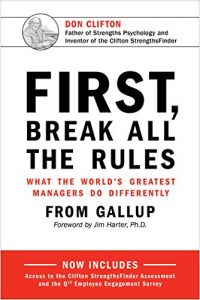
First Break All Rules is about challenging the status quo that exists in the management world and encourages management to adopt a unique and innovative outlook of employee management.
This book is the product of tremendous research conducted by the Gallup organization, comprising of 80,000 managers from various industries and examining concepts around employees satisfaction, hiring and tools and methods to measure and correctly estimate employee-related metrics.
The four keys for breaking the rules and unlock the potential for effective management are to focus on :
1. Selecting Talent:
- The key is to hire employees based on talent more than any other factor.
- Great managers are aware of the significant role of talent in the workplace because there are recurring patterns, thoughts and behaviours.
- One of the biggest mistakes made by managers is to hire entirely based on factors other than talent.
The authors divide talents into 3 broad categories:
Striving talents:Describes the ‘why’ of a person. What exactly motivates them and how badly do they want to stand out.
Thinking talents: Describes the ‘how’ of a person. From how they think, their process of decision making, to their focus, discipline and approach to thinking.
Thinking talents:This describes the ‘who’ of a person. Who do they build relations with, who they socially interact with.
2. Suggesting Outcomes:
- This key means to clearly determine the right outcomes. The lesson is that management is not about direct and immediate control.
- Managers have to realize that by defining the end outcome or results, they will save time on controlling the steps in between.
- Instead of controlling those steps, just focus on enhancing employee performance and keeping the focus on the goal.
- Employees will learn to take responsibility and become more self-reliant.
3. Developing Employee Strengths:
- The third key for effective management is to focus on strengths and stop the compulsive habit of “fixing” people.
- This is a new and better way of focusing on strong points and dealing with weaknesses.
- The end aim is to make the most use out of an employees talent which is already there and putting those to the best use.
4. Finding The Right Fit:
- The fourth and final key is to delegate the right role for an employee’s talents.
- Avoid the habit of promoting employees until they reach their level of incompetence. This offers no good value to anyone.
- Rethink the approach to raises and rewards. It is possible to keep an employee in a role where are most useful and talented.
# Key Takeaways:
– The importance of focusing on employees’ strengths rather than trying to fix their weaknesses
– The need for managers to treat each employee as an individual and tailor their management style accordingly
– The idea that great managers break the rules and do not follow traditional management practices
– The importance of regular communication and feedback between managers and employees
– The concept of “employee engagement” and its impact on productivity and retention
# Practical Application:
– Managers can use the concept of focusing on strengths to assign tasks and projects to employees that align with their strengths, leading to better performance and job satisfaction.
– By treating each employee as an individual, managers can understand their unique needs and motivations, leading to better communication and a more positive work environment.
– Managers can break traditional rules and practices by being open to new ideas and approaches, leading to innovation and growth within the organization.
– Regular communication and feedback can be implemented through one-on-one meetings, team meetings, and performance reviews, leading to improved employee engagement and performance.
– By understanding the concept of employee engagement, managers can take steps to increase it within their team, leading to higher productivity and retention rates.
# Valuable Insights:
– Chapter 1: “The Measuring Stick”
– This chapter discusses the importance of focusing on employees’ strengths and how it can lead to better performance and engagement.
– Chapter 2: “The Raw Data”
– This chapter delves into the 12 questions that measure employee engagement and how managers can use them to improve their team’s engagement levels.
– Chapter 5: “The Art of Interviewing”
– This chapter offers valuable insights on how to conduct effective interviews and hire the right people for the job.
– Chapter 7: “The Power of One”
– This chapter emphasizes the importance of treating each employee as an individual and tailoring management practices to their unique needs.
– Chapter 12: “The Great Manager”
– This chapter summarizes the key qualities and behaviors of great managers and how they break the rules to achieve success.
# Case Studies/Examples:
– The story of a hotel manager who focused on his employees’ strengths and saw a significant increase in customer satisfaction and employee retention.
– The example of a company that implemented regular communication and feedback sessions, leading to a 50% increase in employee engagement.
– The case study of a manager who tailored his management style to each employee’s needs and saw a 30% increase in productivity within his team.
– The story of a manager who broke traditional rules and allowed his team to work remotely, resulting in increased productivity and job satisfaction.
– The example of a company that focused on employee engagement and saw a 20% increase in sales and a 40% decrease in turnover.
Leave a Reply